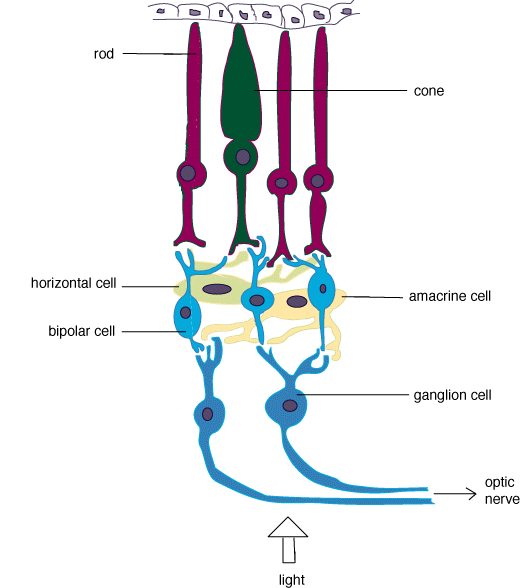- The eyebrow stops sweat running down into the eye.
- Eyelashes help to stop dust blowing on to the eye.
- Eyelids can close automatically (blinking is a reflex) to prevent dust and other particles getting ton to the surface of the cornea.
- Blinking also helps to keep the surface moist by moving liquid secretions (tears) over the exposed surface. Tears also contain enzymes that have an antibacterial function.
* Try this
Trace or copy both diagrams of the eyes. Practice adding the labels. [8 marks]
Distinguishing between rods and cones
Rods and cones are light-sensitive cells in the retina. When stimulated they generate electrical impulses, which pass to the brain along the optic nerve.
The normal retina has rods that see only black, white, and shades of grey and tones and three forms of color cones, red, green, and blue.
Trace or copy both diagrams of the eyes. Practice adding the labels. [8 marks]
Distinguishing between rods and cones
Rods and cones are light-sensitive cells in the retina. When stimulated they generate electrical impulses, which pass to the brain along the optic nerve.
The normal retina has rods that see only black, white, and shades of grey and tones and three forms of color cones, red, green, and blue.
Function
|
Distribution
|
Comments
|
|
Rods
|
Sensitive
to low light intensity.
Detect
shades of grey
|
Found
throught the retina, but none in the centrer of the fovea or in the blind
spot
|
Provide
us with night vision, when we can recognise shapes but not colours
|
Cones
|
Sensitive
only to high light intensity.
Detect
colour (don’t operate in poor light)
|
Concentrated
in the fovea
|
There
are three types, sensitive to red, green and blue light
|
More photos of rods and cones.






No comments:
Post a Comment